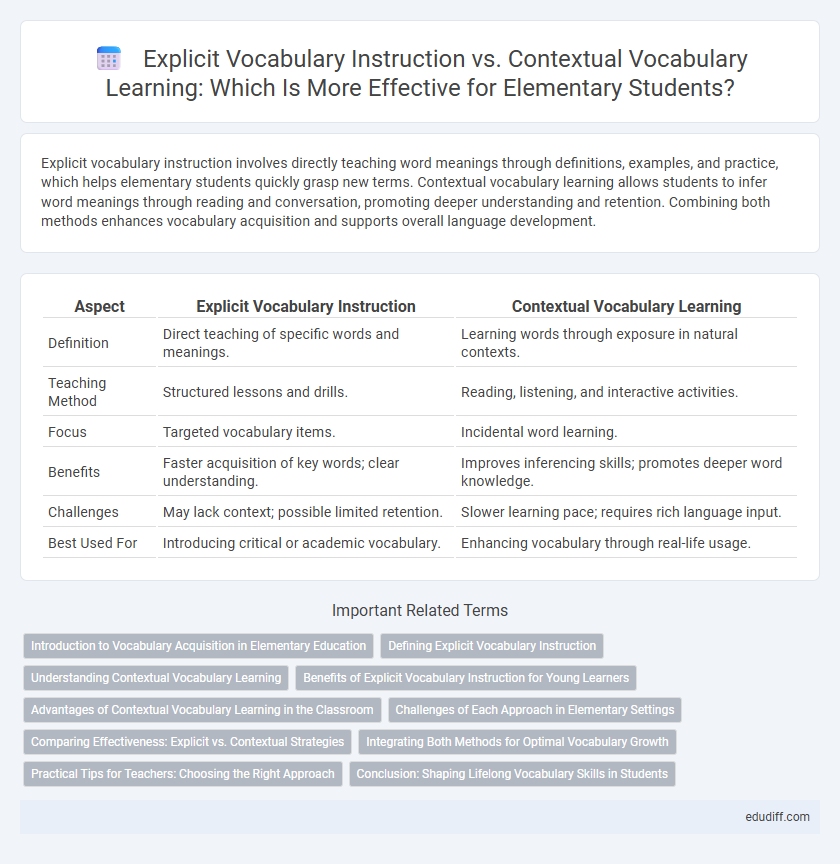Explicit vocabulary instruction involves directly teaching word meanings through definitions, examples, and practice, which helps elementary students quickly grasp new terms. Contextual vocabulary learning allows students to infer word meanings through reading and conversation, promoting deeper understanding and retention. Combining both methods enhances vocabulary acquisition and supports overall language development.
Table of Comparison
| Aspect | Explicit Vocabulary Instruction | Contextual Vocabulary Learning |
|---|---|---|
| Definition | Direct teaching of specific words and meanings. | Learning words through exposure in natural contexts. |
| Teaching Method | Structured lessons and drills. | Reading, listening, and interactive activities. |
| Focus | Targeted vocabulary items. | Incidental word learning. |
| Benefits | Faster acquisition of key words; clear understanding. | Improves inferencing skills; promotes deeper word knowledge. |
| Challenges | May lack context; possible limited retention. | Slower learning pace; requires rich language input. |
| Best Used For | Introducing critical or academic vocabulary. | Enhancing vocabulary through real-life usage. |
Introduction to Vocabulary Acquisition in Elementary Education
Explicit vocabulary instruction in elementary education involves direct teaching of word meanings, pronunciation, and usage, which supports precise language development and reading comprehension. Contextual vocabulary learning encourages students to infer word meanings through exposure to rich reading materials and conversational experiences, promoting natural language acquisition. Both approaches contribute to effective vocabulary growth by balancing structured learning with immersive language environments.
Defining Explicit Vocabulary Instruction
Explicit vocabulary instruction involves directly teaching specific words and their meanings through clearly defined lessons, often using strategies like word analysis, definitions, and examples. This method allows elementary students to systematically build their vocabulary by focusing on targeted words essential for comprehension and academic success. Research shows that explicit instruction can significantly improve students' word knowledge and reading skills compared to incidental learning.
Understanding Contextual Vocabulary Learning
Contextual vocabulary learning enhances elementary students' ability to infer word meanings through surrounding text or real-life situations, promoting deeper comprehension and retention. This method leverages natural language exposure, encouraging learners to connect new vocabulary with their existing knowledge and experiences. Research shows that integrating contextual clues during reading sessions significantly improves long-term vocabulary acquisition compared to isolated memorization.
Benefits of Explicit Vocabulary Instruction for Young Learners
Explicit vocabulary instruction enhances young learners' word retention by providing clear definitions and repeated practice, which strengthens memory connections. Research shows targeted teaching of vocabulary improves reading comprehension and language development more effectively than incidental learning. Structured lessons encourage active engagement, allowing students to grasp word meanings and usage confidently in various contexts.
Advantages of Contextual Vocabulary Learning in the Classroom
Contextual vocabulary learning enhances word retention by allowing students to infer meanings through engaging texts and real-life situations, promoting deeper understanding. It supports language development by integrating new vocabulary naturally within meaningful communication and content areas. This method fosters critical thinking and problem-solving skills as students analyze context clues and usage patterns.
Challenges of Each Approach in Elementary Settings
Explicit vocabulary instruction in elementary settings faces challenges such as limited engagement and the risk of rote memorization without meaningful application, while contextual vocabulary learning can be hindered by students' insufficient background knowledge and difficulty inferring word meanings from text. Teachers must balance providing clear definitions and modeling usage with creating rich, authentic contexts that support comprehension. Effective elementary vocabulary development requires integrating both approaches to address diverse learning needs and promote deep understanding.
Comparing Effectiveness: Explicit vs. Contextual Strategies
Explicit vocabulary instruction involves direct teaching of word meanings and usage, ensuring students have a clear understanding of new terms. Contextual vocabulary learning relies on students inferring meanings from surrounding text, promoting organic word acquisition but often requiring strong reading skills. Research indicates explicit methods lead to faster vocabulary gains, while contextual strategies enhance deeper comprehension over time.
Integrating Both Methods for Optimal Vocabulary Growth
Explicit vocabulary instruction provides elementary students with clear definitions and targeted practice, enhancing word retention and understanding of complex terms. Contextual vocabulary learning allows students to infer meanings through reading varied texts, promoting application and deeper comprehension. Integrating both methods ensures robust vocabulary growth by combining direct teaching with meaningful exposure.
Practical Tips for Teachers: Choosing the Right Approach
Teachers should assess students' needs and language proficiency to decide between explicit vocabulary instruction, which involves direct teaching of word meanings, and contextual vocabulary learning, which encourages discovery through reading and conversation. Combining both methods can enhance retention by providing clear definitions alongside meaningful usage examples. Practical strategies include using word maps, thematic units, and engaging students in discussions that reinforce new vocabulary in diverse contexts.
Conclusion: Shaping Lifelong Vocabulary Skills in Students
Explicit vocabulary instruction provides elementary students with clear definitions and repeated practice, ensuring a strong foundation in word knowledge. Contextual vocabulary learning enhances students' ability to infer meanings from reading and real-life situations, promoting flexible language use. Combining both approaches effectively shapes lifelong vocabulary skills by balancing direct teaching with natural language exploration.
Explicit Vocabulary Instruction vs Contextual Vocabulary Learning Infographic

 edudiff.com
edudiff.com